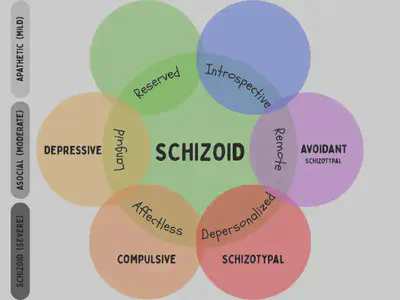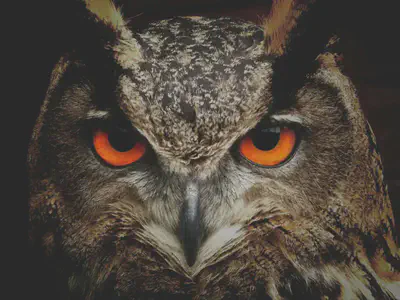Schizoid Personality Subtypes (Millon’s and Ours)
Schizoid Personality Disorder has been in the DSM since its first edition in 1952, but it has lost some of its original criteria involving internal processes like daydreaming/withdrawal into fantasy. As much as I usually love Millon’s work, I do feel saddened by his deficit-based understanding of schizoid personality, which also shows up in his conceptualization of schizoid subtypes…So Doc Bok and I made our own schizoid subtypes! I’ll first start by unpacking Millon’s subtypes below before jumping into ours!
*For a better understanding of schizoid personality disorder, check out podcast episode 34: The Most Misunderstood Personality: Schizoid in the DSM and its blog.

Apathetic Personality: Mild - Closer to “Normal” Level
Starting with Millon, he categorizes his subtypes by severity with mild subtypes being more “healthy” and severe subtypes being more “unhealthy” or at a clinical level (Check out this blog for more info). Let’s start with his less problematic subtypes of schizoid personality, which Millon labeled as Apathetic (instead of Schizoid): The “Reserved” subtype and the “Introspective” subtype.
Reserved
The Reserved Apathetic subtype tends to be phlegmatic, practical, and self-reliant, but also unconfident and self-conscious. They are withdrawn and passive, often fading into the background, and while they are anhedonic, they can express strong emotions if they are with someone they deem safe. They reject imposed routines, schedules, and social norms. They may become deeply absorbed in concrete interests (e.g. mechanics, analytics) but are easily overwhelmed and scattered, leading others to view them as uncommitted, unreliable, or limited.
Introspective
The Introspective Apathetic subtype has a vivid inner world used to cope with isolation and the awareness of life’s emptiness. They prefer concrete work (e.g. tech, science, computers), hold strong values, prefer routine, resist change, and are often seen as self-absorbed and unshakable. They have a strong internal locus of control, work hard, make independent decisions, and don’t care about pleasing people, which results in neglecting social relationships and other responsibilities. They can be blunt and insensitive, especially toward inefficiency/laziness.
Asocial Personality: Moderate - Abnormal Level
The moderate subtypes are at an abnormal level, where they can function, but they definitely run into difficulties. It’s not yet at a level of schizoid personality disorder, so Millon named this level “Asocial,” highlighting two subtypes called “Remote” and “Languid.”
Remote (Avoidant/Schizotypal Features)
The Remote Asocial subtype overlaps with avoidant features, and sometimes more severe schizotypal features. Like the avoidant, they are often shaped by early rejection and hostility, and they often feel unloved and inadequate. To avoid emotional pain, they withdraw so deeply that their emotional and social capacities become stunted. They appear distant, inaccessible, and cut off from pleasure and growth. Severe cases may show schizotypy like odd behaviors, depersonalization, and withdrawal into internal fantasy. They function on the periphery of society and are at risk of being manipulated by others.
Languid (Depressive Features) - Physically Deficient
The Languid Asocial subtype overlaps with depressive features, combining the introversion of the schizoid with the lethargy of the depressive. They struggle with energy, motivation, life, anhedonia, and emptiness, making them seem lazy, weary, and phlegmatic. They also tend to be quiet, dull, and somewhat dependent, coming off to others as weak and unproductive. They do have emotions and experience depressive angst, but they don’t express it strongly because they are so lethargic and inactive.
Schizoid Personality: Severe - Disorder Level
The severe level is where Millon captures actual schizoid personality disorder. He differentiates between “Depersonalized” Schizoids and “Affectless” Schizoids. Remember though, even at the disorder level, there is no psychosis.
Depersonalized (Schizotypal Features) - Cognitively Deficient
The Depersonalized Schizoid subtype overlaps with schizotypal features, presenting as a dreamy, oblivious, and cognitively detached. I like how Millon described it here: “They are much like sleepwalkers who have a physical presence but are totally unaware of what they are doing and what they are thinking or feeling.1” It can feel like they are not actually there, like they’re observers, detached from everything.
Affectless (Compulsive Features) - Emotionally Deficient
The Affectless Schizoid subtype combines the schizoid indifference with compulsive features such as emotional constriction and formality, resulting in little to no emotional expression. The emotional detachment impacts their ability to emotionally connect or relate with others, and they present as chilly, spiritless, unresponsive, uncaring, and unperturbed. However, they prefer structure and seem to be better at adulting than some other schizoid flavors.
Our Subtypes
Because we found Millon’s schizoid subtypes lacking, Doc Bok and I created our own. There’s no research here, but it’s based on our experience and clinical understanding. We’re looking forward to seeing if you relate to these!
Master Masker Schizoid
The Master Masker Schizoid doesn’t necessarily seem like a schizoid personality at first glance, as they can be high functioning in the social realm with strong leadership skills, perhaps running a business, leading presentations, or being a community leader. They might have a more compulsive and/or community-focused flavor, resulting in a strong moral backbone and deep care about people, justice, and kindness. However, they are extremely introverted and find people so draining. It’s not uncommon for them to fall into a pit of exhaustion after work or activist activities. However, they keep going because they work in an area that they deem worthy or sometimes an area necessary for survival, which is where the masking comes in heavily. It’s easier to explain this using the Enneagram language. Here, we might see a 9w1, 5w6, or perhaps just having a 1 or 3 in their tritype.
Quietly Antisocial Schizoid
The Quietly Antisocial Schizoid perhaps secretly wants to burn the world or fantasizes about taking over the world! …but they never would. They’re not dangerous. There might be fantasies or actual action of being “off the grid,” with a stubborn, impermeable, “don’t tell me what to do” attitude. In Enneagram language, they likely have more access to the type 8’s energy, being more motivated by anger to protect those who can’t defend themselves (i.e., children, animals). They can be cynical and reject imposed social conventions and norms, living by their own internal set of rules. However, they can still function well in a job or safe relationships, as they can be very loyal to those in their social bubble, but skeptical of those outside of it.
It’s important to differentiate between this and Millon’s nomadic antisocial, which is an antisocial personality with flavors of schizoid and avoidant1. The nomadic antisocial is apt to remove themselves from society and express anger when provoked. They can be dangerous but aren’t as impulsive as other antisocial types. This is also not a paranoid who withdraws because the world is out to get them.
Depressive Schizoid
While we favor Millon’s Languid Asocial, we actually split it up into two types - a Depressive Schizoid and a Slothy Schizoid. The Depressive Schizoid is detached and possibly ineffectual, but also more introspective and has more empty, depressive, masochistic emotions that results in a negative reinforcement cycle where doing nothing leads to doing more of nothing. They can get stuck and be stubborn to change with a rejection to function, resulting in a passive dependency where others function for them. They don’t want to be rescued, but others might feel a pull to do so. Using the Enneagram, they are likely a double or triple doing repressed/withdrawn type (4, 5, 9), having difficulty self-starting and adulting. They are probably the most likely to show up to treatment.
Slothy Schizoid
Similar to the Depressive Schizoid is the Slothy Schizoid who lives life in slo-mo with no inertia. Their depression isn’t as emotional, but there’s decreased motivation and movement. They can have more dependent flavors, being more easily influenced by others to blend with the social herd so that others spend energy for them so they don’t have to, but it’s not a clingy dependency. They’re loveable and kind, often able to function in the workplace, but they do require a fire under their behind and reminders to get things done. They may require lots of patience simply because they move slower than the rest of society. Using Enneagram language, they are also a double or triple doing repressed/withdrawn tritype, but with less of a 4 focus, and more of a 5 and 9 focus.

Scattered Schizoid
In contrast to slothy slowness, we created a Scattered Professor Schizoid who might come off as intellectually snobbish and have some more access to Enneagram 7 energy, sometimes seeming oddly childlike and fun. While they are often brilliant, smart, and well-studied, they can’t organize to save their life. Or if they’re not super smart, they might be aimless and full of useless information with no direction, perhaps absent-minded, and this may coincide with ADHD. They have a library in their mind, but they probably lost the card catalog. They have a dissociated anxious energy where the chaotic mind shows up, but not the body or emotions. But their tornado-y chaos doesn’t touch other people. It’s not destructive or anxiety provoking, but more amusing. Like a chemistry professor with goggles askew trying to contain the explosion of their beaker that caught their papers on fire, while not realizing the class already left and didn’t take the test he forgot to give!
Let us know what you think of Millon’s subtypes and ours! Comment on YouTube or contact us here! If you want to better understand your own schizoid-ness or the schizoid dynamics of someone you care about, therapy and/or psychological testing can help! If you’re in Virginia (or a PsyPact state), check out our private practice, Quest Psychological and Counseling Services for available services. If you’re a provider stuck on a case, we also offer consultations for mental health professionals!
References
-
Millon, T. (2011). Apathetic styles, asocial types, schizoid disorders: The AAS spectrum. In Disorders of personality: Introducing a DSM/ICD spectrum from normal to abnormal (3rd ed., pp. 663–707). Wiley. https://doi.org/10.1002/9781118099254 ↩︎ ↩︎






